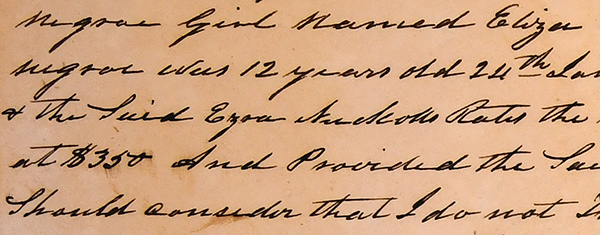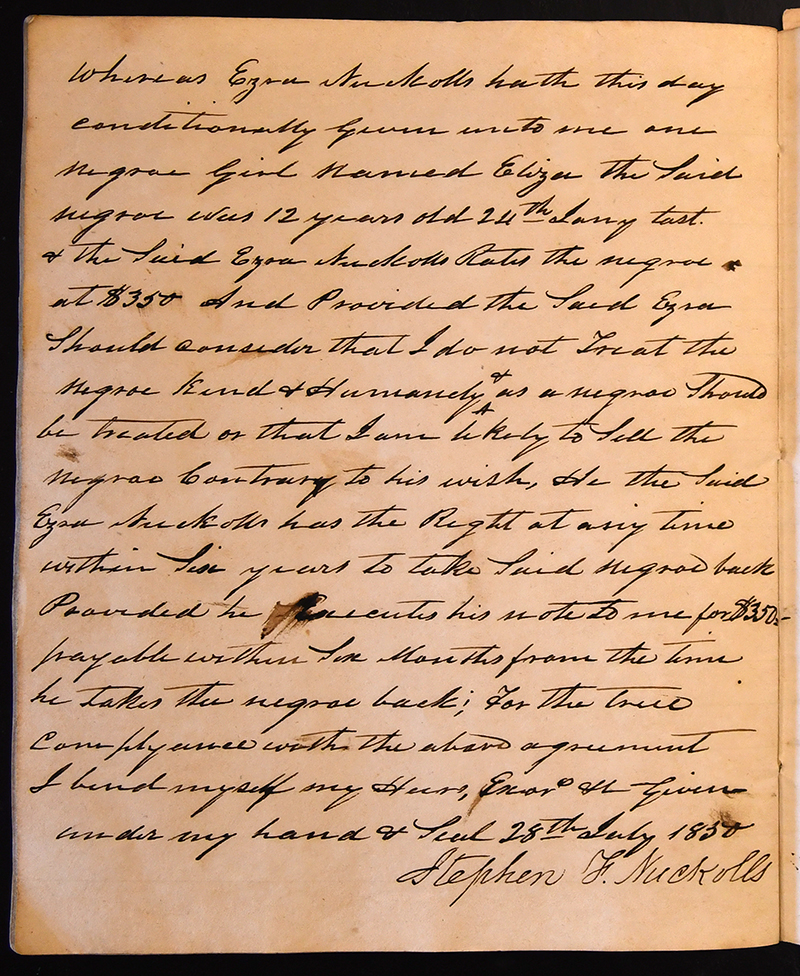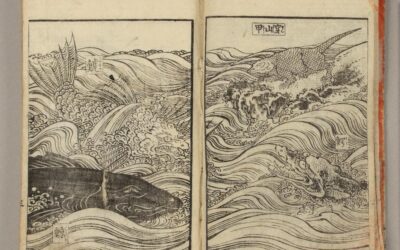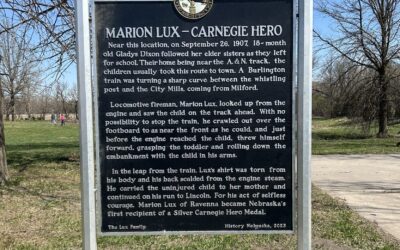
By David L. Bristow, Editor
Eliza Grayson was one of the very first enslaved people brought to Nebraska when the territory opened to white settlers in 1854. Her escape from Nebraska City and capture in Chicago created a sensation in 1860.
In the archives of History Nebraska is a battered composition book titled A Memorandum of Amount of Articles which Ezra Nuckolls give to his Children, December 28th 1838. Among the “articles” described is a “negroe” girl named Eliza.
Eliza had been born the property of Ezra Nuckolls at the family’s home in Grayson County, Virginia. The family moved in 1846 to Atchison County, Missouri, in the state’s northwest corner. There, Ezra’s adult son Stephen “entered the mercantile business.” In 1850 Ezra gave 12-year-old Eliza to 25-year-old Stephen, who signed the following terms in his father’s account book (transcribed below):

Whereas Ezra Nuckolls hath this day conditionally given unto me one negroe Girl named Eliza the Said negroe was 12 years old 24th Jany last. & the Said Ezra Nuckolls Rates the negroe at $350 And Provided the Said Ezra Should consider that I do not Treat the negro Kind & Humanely & as a negroe Should be treated or that I am likely to Sell the negroe Contrary to his wish, He the Said Ezra Nuckolls has the Right at any time within Six years to take Said negroe back Provided he Presents his note to me for $350 – payable within Six Months from the time he takes the negroe back; For the true Complyensce with the above argument I bind myself my Heirs, Exor, etc. Given under my hand & Seal 28th July 1850
Stephen F. Nuckolls
What did it mean to treat a slave “Kind & Humanely”? Did it mean that Stephen was not allowed to beat Eliza if he felt she deserved it? Unlikely—the institution of slavery was maintained with the threat of violence if not always with the act.
Did it mean he couldn’t rape her if he felt so inclined? The rape of enslaved women by their owners was so common as to be an open secret, and the law provided no protection.
* * *
We don’t know how Stephen treated Eliza. We know that soon after Nebraska opened to white settlers in 1854, Stephen brought four slaves into the territory, including Eliza and a younger girl named Celia. Nuckolls is said to be the first of the 1854 settlers to bring slaves to Nebraska. He became the most prominent founder of Nebraska City, established a local bank, and served in the territorial legislature.
In 1858, Eliza and Celia met a man named John Williamson. He was of mixed race, Black and Native American, and he offered to help them escape.
Such a decision was not made lightly. The free state of Iowa lay just across the Missouri River, but it was not safe. The Fugitive Slave Act of 1850 went further than earlier laws, denying suspected slaves their right to a jury trial or even to testify on their own behalf. The law imposed $1,000 fines and up to six month’s imprisonment on anyone who helped a fugitive slave.
And if Eliza and Celia were captured, what would Stephen do to them? He had every legal right to have them whipped, but that wasn’t the worst he could do. Stephen said that Eliza alone was worth $1,200, more than most White families earned in a year. When enslaved people from border states were recaptured, they were often “sold South” to slave markets and ended up on Deep South plantations where escape was all but impossible.
Running away was a huge gamble, and it meant severing all personal ties with one’s past. Eliza and Celia made this decision while very young. Their ages are often reported as 16 and 14, but the Nuckolls account book shows that Eliza was 20 (and doesn’t mention Celia).
Under cover of darkness, they made it across the Missouri River into Iowa. Nuckolls pursued with a posse, but the young women—aided by the Underground Railroad—made their way to Chicago.
* * *

Abolitionist poster, Boston, MA, 1851. Wikimedia Commons
We don’t know what became of Celia, but Eliza found work as a domestic servant in a Clark Street brothel. At some point she told her story to one of the women—and was betrayed. On November 12, 1860, Stephen and a “kidnapper for hire” came to take her back.
Eliza screamed as the men dragged her down Clark Street. Some local abolitionists intervened with help from law enforcement. Federal law was on Stephen’s side; it specifically required law enforcement to help him. Instead, Stephen and Eliza were both arrested for disorderly conduct and held at an armory building on the site of today’s Willis Tower (aka Sears Tower). When the sheiriff’s deputies attempted to transfer Eliza to a nearby jail, an abolitionist mob seized her and took her away. Onlookers didn’t think the deputies tried very hard to keep her, and some thought that at least one of the deputies was in on the plan to help Eliza escape to Canada. It was said she escaped on a Lake Michigan boat.
And that is the last that is known of Eliza Grayson. Stephen Nuckolls returned home empty-handed. Later that year the Nebraska Territorial Legislature overrode the governor’s veto to abolish slavery in the territory. Meanwhile, Southern states had begun seceding from the United States explicitly to protect and expand slavery in defiance of the newly-elected president, Abraham Lincoln. The Civil War began the following spring. Stephen didn’t fight, but was a Confederate sympathizer. He is the namesake of Nuckolls County, Nebraska, and of Nuckolls Square Park in Nebraska City.
No monuments exist to Eliza Grayson or to Celia, or to any of the other enslaved Nebraskans, but in 2016 Arlington High School teacher Barry Jurgensen led a 527-mile walk from Nebraska City to Chicago to honor the young women and to raise awareness about present-day human trafficking.
(9/1/2020)
For further reading:
“When a Chicago Street Mob Rescued a Fugitive from Slavery,” Chicago Magazine, June 24, 2019.
“Local retraces former Nebraska City slaves’ first, last steps to freedom,” Nebraska City News-Press, August 17, 2016.
“HumaNature Episode 19: Freedom” Wyoming Public Media, Mar. 29, 2017. (Podcast featuring interview with Barry Jurgensen.)
“Nuckolls Family [RG2325.AM],” finding aid for Nuckolls Family collection at History Nebraska.




